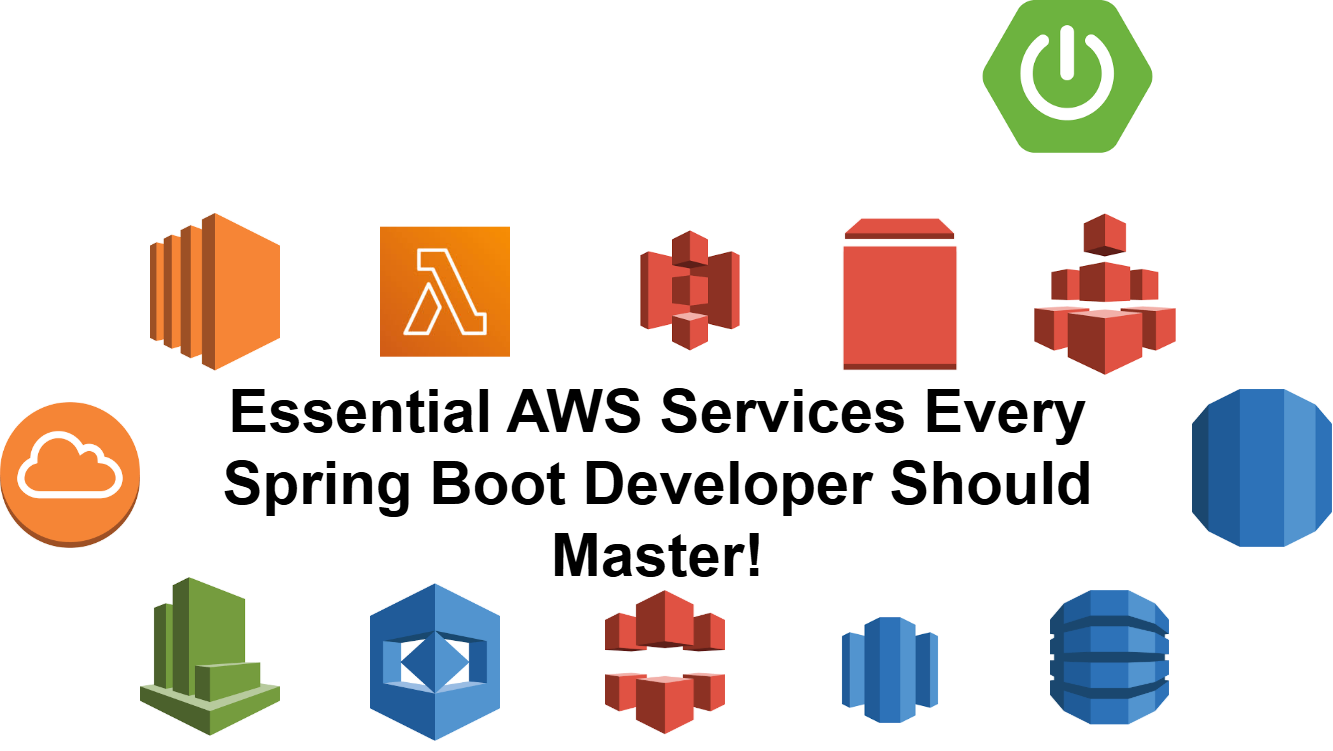Essential AWS Services Every Spring Boot Developer Should Master!
For a Spring Boot developer looking to integrate with AWS, several services are highly beneficial to master. These services will help you build, deploy, and scale your Spring Boot applications efficiently on AWS. 🌐🚀
1. Amazon EC2 (Elastic Compute Cloud) 🖥️
- Purpose: EC2 is essential for running virtual machines on AWS. You can use EC2 instances to host your Spring Boot applications.
- Key Skills: Launching EC2 instances, configuring auto-scaling, setting up security groups, and managing instances using EC2 CLI or AWS SDK.
2. Amazon S3 (Simple Storage Service) 🗂️
- Purpose: S3 is used for storing static assets, backups, and large files like images or documents.
- Key Skills: Uploading and retrieving files, setting up buckets, configuring access control policies, and using the AWS SDK in your Spring Boot app.
3. Amazon RDS (Relational Database Service) 🏛️
- Purpose: For managing relational databases like MySQL, PostgreSQL, and Oracle. Spring Boot applications commonly interact with databases, and RDS simplifies database management.
- Key Skills: Connecting Spring Boot to RDS, configuring database security, scaling RDS, and monitoring performance.
4. Amazon DynamoDB ⚡
- Purpose: DynamoDB is a NoSQL database that offers fast and flexible key-value access. It's great for applications with unpredictable workloads or for handling large-scale data.
- Key Skills: Integrating DynamoDB with Spring Boot using the AWS SDK, designing schemas for performance, and handling NoSQL queries.
5. Amazon SNS (Simple Notification Service) 📣
- Purpose: SNS is a pub/sub messaging service that allows Spring Boot applications to send notifications to users or other services.
- Key Skills: Sending email, SMS, or mobile push notifications from a Spring Boot application, and integrating SNS with other AWS services.
6. Amazon SQS (Simple Queue Service) 📦
- Purpose: SQS is a fully managed message queue service that helps decouple services. It's often used to implement asynchronous processing in Spring Boot applications.
- Key Skills: Sending and receiving messages from SQS queues, integrating SQS with Spring Boot’s asynchronous capabilities.
7. AWS Lambda 🧑💻
- Purpose: AWS Lambda allows you to run code without provisioning or managing servers. It can be used for serverless computing, where Spring Boot apps handle microservice functionality.
- Key Skills: Deploying Spring Boot as a Lambda function (using Spring Cloud Function), integrating with other AWS services, and setting up event-driven applications.
8. Amazon API Gateway 🌐
- Purpose: API Gateway is used to create, publish, maintain, monitor, and secure APIs. You can use it to expose your Spring Boot microservices to the web.
- Key Skills: Creating RESTful APIs, configuring API Gateway with Spring Boot applications, setting up security with API keys, and integrating with Lambda and DynamoDB.
9. AWS Elastic Beanstalk 🚢
- Purpose: Elastic Beanstalk simplifies deploying Spring Boot applications by automating the environment provisioning and management.
- Key Skills: Deploying Spring Boot applications to Elastic Beanstalk, setting environment variables, and scaling applications automatically.
10. Amazon CloudWatch 📊
- Purpose: CloudWatch is used for monitoring your Spring Boot application logs and performance metrics in real-time.
- Key Skills: Configuring CloudWatch logs and metrics, setting alarms for application health, and using CloudWatch Insights to analyze logs.
11. AWS IAM (Identity and Access Management) 🔒
- Purpose: IAM allows you to manage access to AWS resources securely.
- Key Skills: Creating and managing IAM users, roles, and policies to control access to your Spring Boot application’s AWS resources.
12. Amazon Elastic Load Balancer (ELB) ⚖️
- Purpose: ELB helps distribute incoming application traffic across multiple instances, ensuring high availability and fault tolerance for your Spring Boot applications.
- Key Skills: Configuring load balancing for scalable Spring Boot applications and monitoring health checks.
13. Amazon CloudFront 🌍
- Purpose: CloudFront is a content delivery network (CDN) that caches your content globally for faster delivery to users.
- Key Skills: Configuring CloudFront to cache static assets like images, JS, and CSS files for your Spring Boot application.
14. Amazon VPC (Virtual Private Cloud) 🏡
- Purpose: VPC allows you to create isolated networks within AWS, giving you complete control over your network configuration.
- Key Skills: Setting up VPCs, subnets, route tables, security groups, and networking for Spring Boot applications that require private cloud environments.
15. AWS Secrets Manager 🔑
- Purpose: Secrets Manager securely manages credentials, API keys, and other sensitive information.
- Key Skills: Storing and retrieving credentials in Secrets Manager from Spring Boot applications to avoid hard-coding sensitive data.
🚀 Unlock the Secrets to Building Resilient and Scalable Microservices!
🌟 Master Spring Boot 3 and Spring Cloud with Magnus Larsson’s expert guide.
💡 Dive into the latest tech like Istio and Kubernetes—your ultimate tools for microservice success.
🎯 15% OFF—Grab your copy NOW and start building the future of software development!
📚 Don’t miss out on this limited-time offer! Boost your skills and career today. 💥
👉 Buy Now & Save 15%!
💡 Dive into the latest tech like Istio and Kubernetes—your ultimate tools for microservice success.
🎯 15% OFF—Grab your copy NOW and start building the future of software development!
📚 Don’t miss out on this limited-time offer! Boost your skills and career today. 💥
👉 Buy Now & Save 15%!










